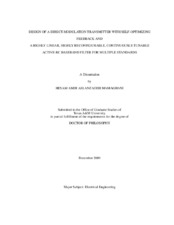| dc.description.abstract | This work consists of two main parts: i) Design and implementation of a compact current-reusing 2.4GHz direct-modulation transmitter with on-chip automatic tuning; ii) Design and implementation of a novel highly-reconfigurable, continuously tunable, power-adjustable Active-RC filter for multiple standards. The design, analysis, and experimental verification of a proposed self-calibrating, current reused 2.4GHz, direct-modulation transmitter are introduced. A stacked arrangement of the power amplifier/voltage-controlled oscillator is presented along with a novel LC-tank-tuning algorithm with a simple, low-cost, on-chip implementation. To transmit maximum power, the tuning loop ensures the PA's resonant tank is centered around the operating frequency, and the loop requires no ADC, DSP, or external signal generator. This work also details the proposed tuning-loop algorithm and examines the frequency-dependent nonlinear power-detector. The system was implemented in TSMC 0.18[mu]m CMOS, occupies 0.7 mm² (TX) + 0.1 mm² (self tuning), and was measured in a QFN48 package on FR4 PCB. Automatically adjusting the tank-tuning bits within their tuning range results in >4dB increase in output power. With the self-tuning circuit active, the transmitter delivers a measured output power of > 0dBm to a 100-[omega] differential load, and the system consumes 22.9 mA from a 2.2-V supply. A biquad design methodology and a baseband low-pass filter is presented for wireless and wireline applications with reconfigurable frequency response, selectable order (1st/3rd/5th), continuously tunable cutoff frequency (1MHz-20MHz) and adjustable power consumption (3mW-7.5mW). A discrete capacitor array coarsely tunes the low-pass filter, and a novel Continuous Impedance Multiplier (CIM) then finely tunes the filter. Resistive/capacitive networks select between the Chebyshev and Inverse Chebyshev approximation types. Also, a new stability metric for biquads, Minimum Acceptable Phase Margin (MAPM), is presented and discussed in the context of filter compensation and passband ripple considerations. Experimental results yield an IIP3 of 31.3dBm, a THD of -40dB at 447mV[subscript pk, diff] input signal amplitude, and a DR of 71.4dB. The filters tunable range covers frequencies from 1MHz to 20MHz. In Inverse Chebyshev mode, the filter achieves a passband group delay variation less than ±2:5%. The design is fabricated in 0.13[mu]m CMOS, occupies 1.53mm², and operates from a 1-V supply. | en |


